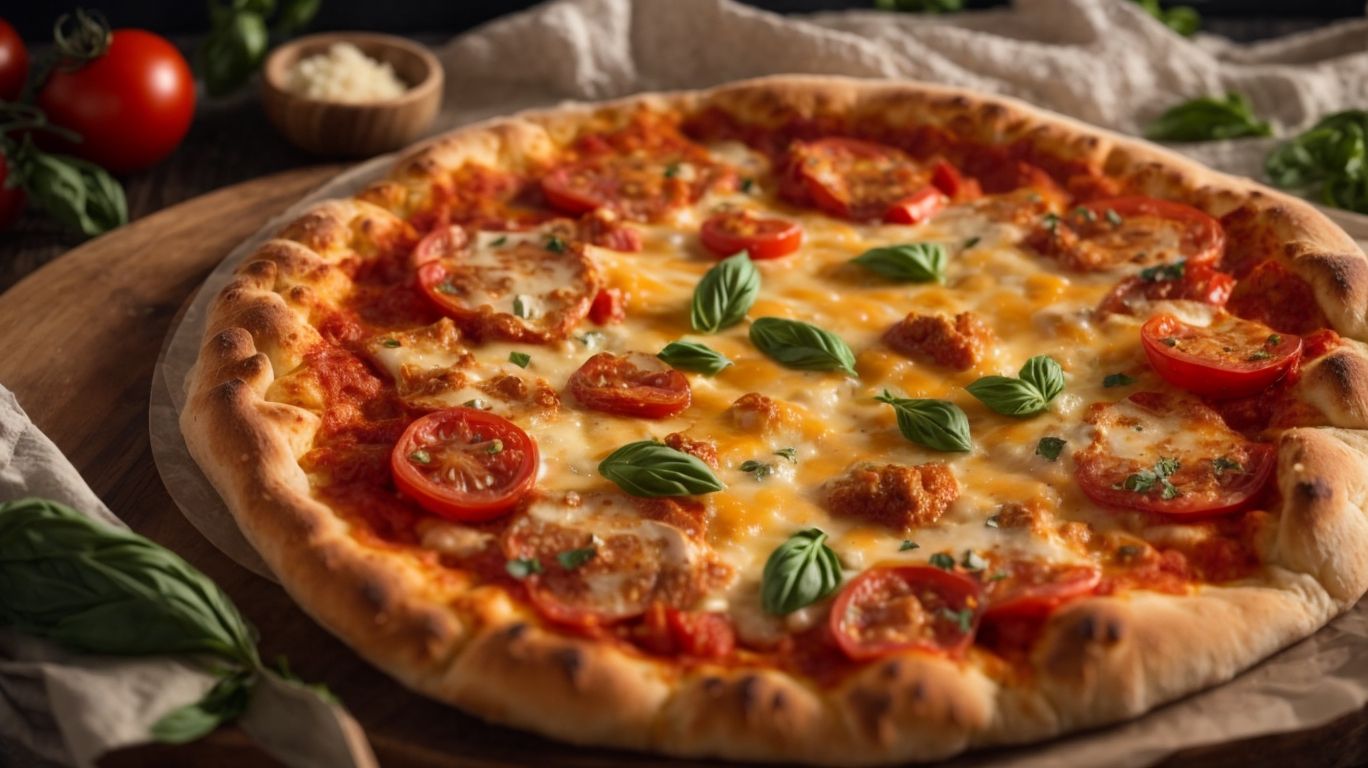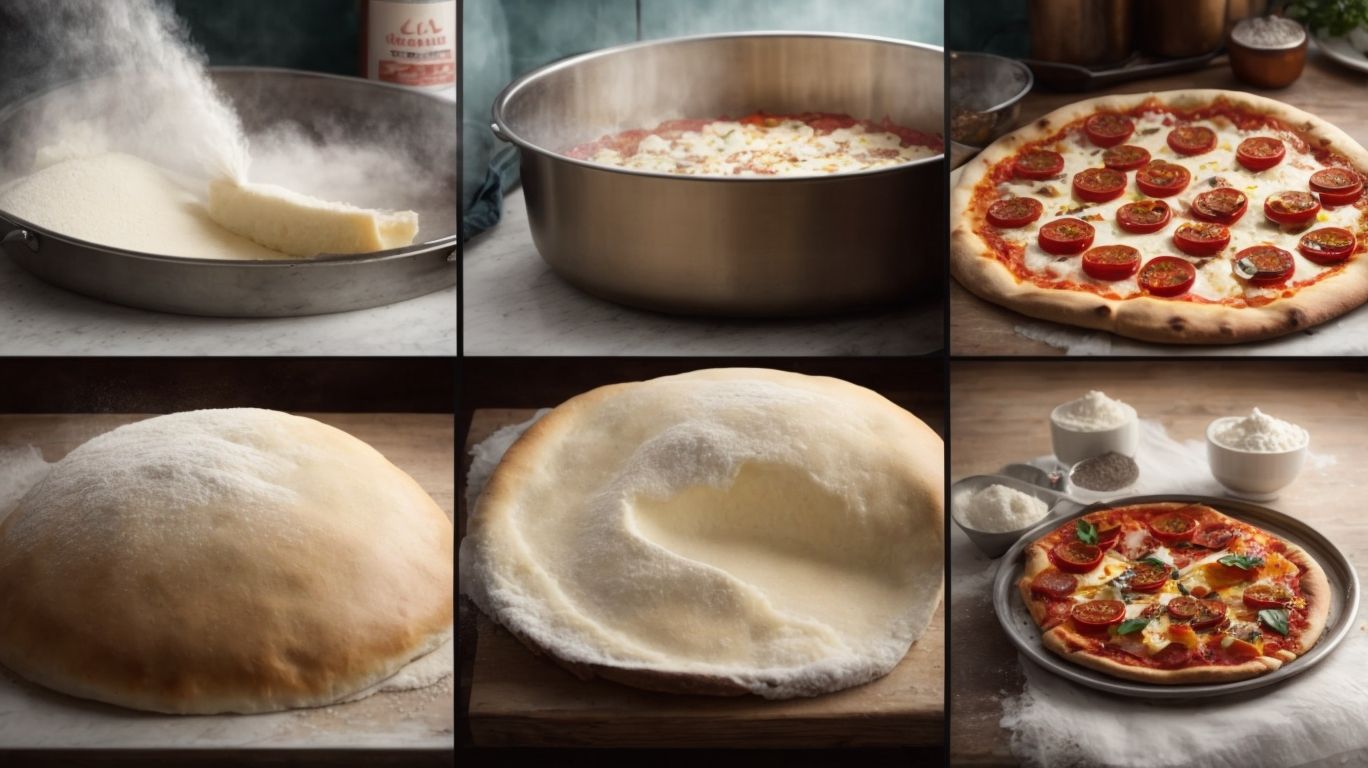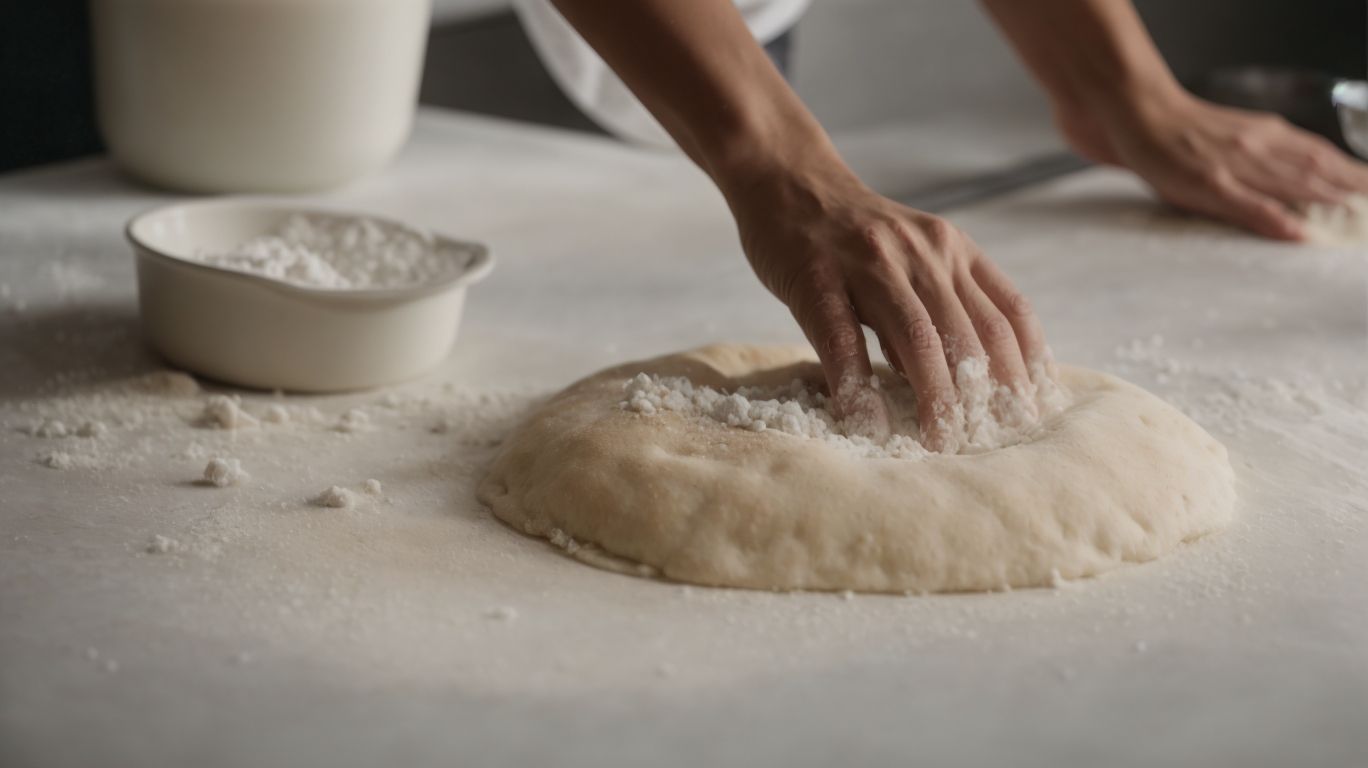How to Bake Dough for Pizza?
Are you craving the perfect homemade pizza but struggling to get the dough just right? Look no further!
This article will explore everything you need to know about creating the perfect pizza dough. From the essential ingredients and the best flour to use, to the ideal flour to water ratio and the process of kneading and shaping the dough, we’ve got you covered.
We’ll also discuss different methods of baking the dough and provide some handy tips for achieving pizza perfection. So, let’s get baking and elevate your pizza game to the next level!
Key Takeaways:
What is the Perfect Dough for Pizza?

Credits: Poormet.Com – Gabriel Harris
Creating the perfect dough for pizza is a blend of art and science, where the right combination of ingredients and techniques results in a delicious crust that complements your favorite toppings.
Pizza dough serves as the foundation of the entire pizza-making process, acting as the canvas for the flavorful masterpiece that follows. Flour, water, yeast, and olive oil harmonize to create a dough that is both elastic yet crispy, chewy yet light, offering the ideal texture to support the toppings. Proper kneading not only develops gluten for structure but also ensures an even distribution of ingredients for uniform taste. The rising stage is crucial, allowing the dough to ferment and develop complex flavors and aeration that result in a puffy, airy crust.
What are the Ingredients for Pizza Dough?
The key ingredients for crafting the perfect pizza dough include flour, water, yeast, olive oil, salt, and a dash of creativity to infuse flavor into every bite.
High-quality flour forms the foundation of any excellent pizza dough, providing the necessary structure and a distinctive flavor profile. It’s crucial to choose a flour with a higher protein content, such as bread flour, as this helps create a chewier texture.
When activating the yeast, ensure the water temperature is between 105-110°F to wake up the yeast cells gently, promoting optimal fermentation.
Olive oil not only enriches the dough but also adds depth and complexity to the overall taste. Incorporating these ingredients thoughtfully results in a dough that is not only easy to work with but also produces a crust that is flavorful, airy, and perfectly textured.
What is the Best Flour for Pizza Dough?
Selecting the best flour for pizza dough can elevate your homemade pizza experience, whether opting for all-purpose white flour, bread flour, or venturing into the realm of whole wheat dough for added nuttiness and nutrition.
Regarding all-purpose flour, it is a versatile choice that many home cooks prefer for its accessibility and ability to produce a dough with a good balance of chewiness and tenderness. On the other hand, bread flour, with its higher protein content, is ideal for those who crave a chewier and more structured crust that holds up well to toppings. Whole wheat flour introduces a depth of flavor and a slightly denser texture, perfect for those looking for a heartier and more wholesome pizza experience. Each type of flour brings its own unique characteristics to the dough, influencing not only the taste but also the texture and overall baking process.
What is the Ratio of Flour to Water for Pizza Dough?
Achieving the ideal ratio of flour to water is crucial in pizza dough preparation, ensuring the dough achieves the perfect balance of elasticity and hydration for a delightful crust.
Regarding crafting the perfect pizza dough, consistency is key. The flour-to-water ratio plays a pivotal role in determining the dough’s final texture and structure. Too little water can result in a dry, tough dough that lacks the desired stretchiness, while too much water can lead to a sticky, difficult-to-handle consistency. Striking the right balance between flour and water enables the dough to rise beautifully during baking, creating that sought-after airy and chewy crust that is characteristic of a top-notch pizza.
How to Prepare the Dough for Baking?
Preparing the pizza dough for baking involves a series of steps, from kneading the ingredients to letting the dough rise, setting the foundation for a delicious homemade pizza.
Once the dough ingredients are mixed thoroughly, the kneading process begins. Kneading is crucial to develop the dough’s gluten structure, providing elasticity and strength. This can be done by hand or using a stand mixer with a dough hook attachment. Patience is key during this stage, as it may take several minutes of kneading for the dough to reach the desired smooth and slightly tacky consistency. After kneading, allowing the dough to rise in a warm, draft-free place is essential. This period allows the yeast to ferment, leading to a light, airy texture in the dough. The rising time can vary depending on the recipe, but it generally takes around 1-2 hours.
What is the Process of Kneading the Dough?
The kneading process is a critical step in developing the gluten structure of the dough, creating that perfect balance of chewiness and tenderness in your pizza crust.
Regarding kneading pizza dough, the goal is to evenly distribute ingredients, develop gluten, and incorporate air for a light and airy crust. To achieve this, different techniques can be employed depending on the recipe and desired outcome. Some common methods include the folding and stretching technique which involves pulling the dough towards you, folding it over, and pushing it away with the heel of your hand.
Timing is crucial during kneading – too little and the gluten won’t have developed enough, resulting in a dense crust, while too much kneading may lead to an overly tough texture. Visual cues like the windowpane test can help determine when the dough has been kneaded adequately. This test involves stretching a small piece of dough between your fingers to see if it forms a thin, translucent membrane without tearing, indicating proper gluten development.
How to Let the Dough Rise?
Allowing the dough to rise is a crucial stage in pizza making, as it gives the yeast time to work its magic, creating a light and airy base for your toppings.
Regarding achieving the perfect rise in your pizza dough, optimal conditions for proofing play a significant role. Warm environments are essential for activating the yeast and facilitating fermentation. A temperature between 75-85°F is ideal for encouraging yeast activity without killing it. Giving the dough adequate time for fermentation is key. This typically ranges from 1 to 2 hours, allowing the dough to double in size, resulting in a more flavorful and elastic dough.
How to Shape the Dough for Baking?
Shaping the pizza dough is the final touch before baking, where you can craft your preferred crust thickness and ensure an even distribution of toppings for a delicious outcome.
There are several techniques to master the art of dough shaping, each affecting the final pizza in its unique way. One common method is stretching the dough, gently pulling and rotating it to the desired size.
For those who prefer a thinner crust, a rolling pin can be used, applying controlled pressure to achieve the desired thickness. Alternatively, pressing the dough by hand creates a rustic, irregular edge, perfect for a homemade look.
Customizing the crust style also allows for creativity – whether it’s a classic round shape, a rectangular Sicilian style, or even a stuffed crust filled with gooey cheese.
What are the Different Methods of Baking Pizza Dough?

Credits: Poormet.Com – Mark Clark
Exploring the various baking methods for pizza dough opens up a world of possibilities, whether one prefers the crispy texture of a stone-baked crust or the convenience of a baking sheet.
For those aiming for a rustic, crispy crust, using a pizza stone is key. The stone evenly distributes heat, resulting in a perfectly crisp bottom. On the other hand, opting for a baking sheet can yield a chewier middle with a slightly crisp bottom. A specialized pizza pan can achieve a thin, evenly cooked crust. Temperature settings play a crucial role – high temperatures for shorter durations for a quick bake, or lower temperatures for longer durations for a slower, more thorough bake. Experimenting with these methods can lead to finding your perfect pizza crust texture.
Baking on a Pizza Stone
Baking pizza on a stone offers a traditional approach that yields a crispy crust with delightful charred spots, enhancing the overall flavor and texture of your homemade pie.
Preheating the pizza stone is crucial to achieve that perfect crust. The even heat distribution provided by the stone ensures that the pizza cooks uniformly, preventing any sogginess in the center. Cornmeal is commonly used to prevent sticking and aid in easy transfer of the pizza onto the stone. The direct contact with the hot surface of the stone creates a beautiful sear on the underside of the crust, resulting in a crispy and well-cooked base, while the toppings gently meld together to create a flavorful combination.
Baking on a Baking Sheet
Utilizing a baking sheet for pizza baking offers convenience and versatility, allowing you to experiment with different toppings and crust styles without the need for specialized equipment.
Baking pizza on a sheet is a straightforward process that starts with preheating your oven and preparing your dough. For a crispy bottom crust, preheat the baking sheet in the oven before placing the dough on it. This initial blast of heat creates a nice sear on the bottom, ensuring a crunchy base.
Once you’ve assembled your pizza with fresh ingredients of your choice, slide it onto the hot baking sheet. The even heat distribution of the sheet helps in achieving a uniformly cooked pizza with a golden-brown crust.
Clean-up is a breeze as well – simply remove the finished pizza, wipe down the baking sheet, and it’s ready for the next creation, making it a convenient option for busy weeknights or casual gatherings with friends.
Baking on a Pizza Pan
Baking pizza on a pan offers a reliable method for achieving a well-cooked crust with a golden bottom, making it ideal for those seeking a consistent and evenly baked result.
When you bake pizza on a pan, the heat is distributed evenly across the entire crust, ensuring that every bite is cooked to perfection. The pan also provides a convenient way to handle the pizza in and out of the oven, making the process smoother and easier.
By greasing the pan properly, you create a non-stick surface that helps in achieving a crispy yet tender crust, enhancing the overall texture of the pizza. Adjusting the baking times allows you to control the level of crispiness and thickness of the crust, catering to your preferences and creating a custom-made pizza experience.
What are Some Tips for Baking the Perfect Dough for Pizza?
Mastering the art of baking the perfect dough for pizza involves attention to detail and a few insider tips that can elevate your homemade pizza game to the next level.
One crucial step in achieving a fantastic pizza crust is ensuring your oven is preheated adequately, usually to around 500°F, allowing for the perfect balance of crispy exterior and fluffy interior.
When selecting ingredients, opt for high-quality flour, fresh yeast, and the finest olive oil to enhance the dough’s flavor and texture.
Distributing your toppings evenly across the dough ensures each bite is a delicious symphony of flavors.
Rotating the pizza halfway through baking promotes even cooking and a beautiful golden crust.
Allowing the dough to rest before slicing ensures the toppings set and the flavors meld together for a mouthwatering experience.
Preheat the Oven and Baking Surface
Preheating the oven and baking surface is a crucial step in ensuring even cooking and a perfectly crisp crust that forms the foundation of your delectable pizza creation.
When preheating the oven for pizza-making, it’s essential to set the temperature correctly based on the type of crust you desire. For a thin and crispy crust, a high temperature of around 500-550°F creates that delightful crunch. On the other hand, if you prefer a thicker, chewier crust, opt for a lower temperature, typically around 425-475°F.
Preheating a baking stone or sheet along with the oven can significantly impact the finished product. Placing the pizza on a preheated stone or sheet helps in creating a nice, evenly browned crust, as the heat transfer is quick and uniform.
Use High-Quality Ingredients
The quality of your pizza dough and toppings hinges on the ingredients you choose, making it essential to opt for premium selections that enhance the overall flavor and texture of your homemade pizza.
One of the key components that significantly impacts the taste and texture of your pizza is the flour. Fresh flour can make a world of difference in the crust – providing a light, airy texture and a delicious flavor. Regarding olive oil, using high-quality extra virgin olive oil not only adds richness but also brings a subtle fruity note.
The choice of cheeses plays a crucial role in achieving that perfect gooey, stringy melt. Opting for authentic Italian mozzarella or a blend of aged cheeses can elevate your pizza to gourmet levels.
Don’t Overload the Pizza with Toppings
Resist the temptation to overload your pizza with toppings, as a balanced distribution ensures proper cooking and allows the flavors of each ingredient to shine through in every bite.
Regarding topping moderation in pizza preparation, less is often more. Optimal quantities of each topping can vary depending on personal preference, but a general rule of thumb is to avoid overcrowding the surface. Proper spacing between toppings is crucial for even cooking, preventing the pizza from becoming soggy or undercooked in certain areas. Layering techniques play a significant role in achieving a harmonious flavor profile. Start with a base of sauce or cheese, then strategically place toppings to ensure a well-balanced distribution.
Rotate the Pizza While Baking
For even browning and cooking, consider rotating your pizza halfway through baking to ensure a uniform finish and optimal crispness on all sides of your delectable creation.
Rotating the pizza during the baking process helps in distributing heat evenly, preventing the risk of one side being overcooked while the other remains underdone. This technique is particularly useful when dealing with pizzas that have uneven toppings or varying thickness.
When rotating your pizza, aim to turn it around 180 degrees using a pizza peel or oven-safe spatula. This ensures that each part of the pizza receives an equal amount of heat exposure, promoting a consistent bake and a golden crust.
Allow the Pizza to Rest Before Slicing
Patience pays off in pizza making; allow your freshly baked creation to rest briefly before slicing, allowing the flavors to meld and the crust to settle for a satisfying dining experience.
While the temptation to immediately dig into your hot, aromatic pizza might be strong, taking a few extra minutes to let it rest can significantly enhance its overall quality. Resting the pizza post-baking is crucial for flavor development, allowing the various ingredients to harmonize and intensify their taste profiles. This short interlude also benefits the texture of the pizza, with the crust becoming more crisp and sturdy, making slicing and serving a breeze. A resting time of about 5-10 minutes is generally recommended, giving the pizza ample time to settle and reach its peak deliciousness.
Frequently Asked Questions
What is the best flour to use for pizza dough?
The best flour to use for pizza dough is all-purpose flour. This flour will give you a crispy and chewy crust, perfect for your pizza.
How long should I let my pizza dough rise?
You should let your pizza dough rise for at least 1 hour, but it can be left to rise for up to 24 hours in the refrigerator for a more flavorful crust.
Can I use a rolling pin to stretch my pizza dough?
Yes, you can use a rolling pin to stretch your pizza dough, but it is not recommended. Hand-stretching the dough will give you a better texture and shape for your pizza crust.
What is the best temperature to bake pizza dough at?
The best temperature to bake pizza dough at is 500-550°F (260-290°C). This high heat will give you a crispy crust and cook the toppings evenly.
Is it necessary to preheat the oven before baking pizza dough?
Yes, it is necessary to preheat the oven before baking pizza dough. Preheating allows the oven to reach the desired temperature and ensures that the pizza cooks properly.
How can I prevent my pizza dough from sticking to the pan?
To prevent your pizza dough from sticking to the pan, make sure to lightly oil the pan before placing the dough on it. You can also sprinkle some cornmeal or semolina on the pan to create a nonstick surface.

